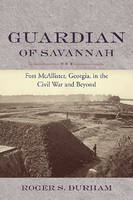
Guardian of Savannah
Fort McAllister, Georgia, in the Civil War and Beyond
Seiten
2008
University of South Carolina Press (Verlag)
978-1-57003-742-9 (ISBN)
University of South Carolina Press (Verlag)
978-1-57003-742-9 (ISBN)
- Titel z.Zt. nicht lieferbar
- Versandkostenfrei
- Auch auf Rechnung
- Artikel merken
The southern anchor in the coastal defenses of Savannah, Georgia, Fort McAllister was constructed of sand and mud in April 1863 on the Great Ogeechee River. This book offers an account of how the fort withstood not only devastating naval assaults but also the effects of time.
This book tells the dramatic story of how an earthen fort defended a southern city against ironclad monitors.The southern anchor in the coastal defenses of Savannah, Georgia, Fort McAllister was constructed of sand and mud in April 1863 on the Great Ogeechee River, twelve miles south of the Savannah River. Durham offers a comprehensive history of the fort's construction, strategic importance during the Civil War, and postwar neglect and restoration in this vivid account of how an earthen defense withstood not only devastating naval assaults but also the effects of time. In re-creating the story, Durham intertwines historical facts with human fates through frequent use of primary sources, letting the fort's defenders speak for themselves.Over the course of the war, McAllister's original four-battery design was augmented to include twenty-two guns, making the fort a more important target and a much more difficult challenge to Union assaults. The monitor U. S. S. Montauk was twice summoned to take Fort McAllister and twice failed. In a third Union attempt, three ironclads and a supporting fleet of wooden gunboats bombarded the fort for seven hours, though the defenders suffered no casualties and the fort withstood the blasts. In all, seven unsuccessful attacks were made against the fort. Fort McAllister's final threat did not come from the water but from the western reaches of the state. In December 1864 General William T. Sherman's famed March to Sea negated the viability of coastal defenses and Fort McAllister, like Savannah itself, fell at last.In the 1930s the site was owned by the industrialist Henry Ford, who was instrumental in the initial preservation efforts to restore the fort as a historical monument for future generations. Ownership of the fort later passed to the International Paper Company, which in turn deeded the land to the State of Georgia. The historical site was opened to the public in 1963, on the centennial of the bombardment by the Union ironclads.
This book tells the dramatic story of how an earthen fort defended a southern city against ironclad monitors.The southern anchor in the coastal defenses of Savannah, Georgia, Fort McAllister was constructed of sand and mud in April 1863 on the Great Ogeechee River, twelve miles south of the Savannah River. Durham offers a comprehensive history of the fort's construction, strategic importance during the Civil War, and postwar neglect and restoration in this vivid account of how an earthen defense withstood not only devastating naval assaults but also the effects of time. In re-creating the story, Durham intertwines historical facts with human fates through frequent use of primary sources, letting the fort's defenders speak for themselves.Over the course of the war, McAllister's original four-battery design was augmented to include twenty-two guns, making the fort a more important target and a much more difficult challenge to Union assaults. The monitor U. S. S. Montauk was twice summoned to take Fort McAllister and twice failed. In a third Union attempt, three ironclads and a supporting fleet of wooden gunboats bombarded the fort for seven hours, though the defenders suffered no casualties and the fort withstood the blasts. In all, seven unsuccessful attacks were made against the fort. Fort McAllister's final threat did not come from the water but from the western reaches of the state. In December 1864 General William T. Sherman's famed March to Sea negated the viability of coastal defenses and Fort McAllister, like Savannah itself, fell at last.In the 1930s the site was owned by the industrialist Henry Ford, who was instrumental in the initial preservation efforts to restore the fort as a historical monument for future generations. Ownership of the fort later passed to the International Paper Company, which in turn deeded the land to the State of Georgia. The historical site was opened to the public in 1963, on the centennial of the bombardment by the Union ironclads.
Roger S. Durham is the director of the U.S. Army Heritage Museum in Carlisle Barracks, Pennsylvania. Durham is a graduate of the University of Wisconsin and Georgia Southern University. His other books include High Seas and Yankee Gunboats: A Blockade-Running Adventure from the Diary of James Dickson and Fort McAllister.
| Erscheint lt. Verlag | 30.9.2008 |
|---|---|
| Zusatzinfo | 72 illustrations |
| Verlagsort | South Carolina |
| Sprache | englisch |
| Themenwelt | Geschichte ► Allgemeine Geschichte ► Neuzeit (bis 1918) |
| Geisteswissenschaften ► Geschichte ► Regional- / Ländergeschichte | |
| Geschichte ► Teilgebiete der Geschichte ► Militärgeschichte | |
| ISBN-10 | 1-57003-742-6 / 1570037426 |
| ISBN-13 | 978-1-57003-742-9 / 9781570037429 |
| Zustand | Neuware |
| Haben Sie eine Frage zum Produkt? |
Mehr entdecken
aus dem Bereich
aus dem Bereich
Europa 1848/49 und der Kampf für eine neue Welt
Buch | Hardcover (2023)
DVA (Verlag)
CHF 67,20
Giordano Bruno - ein ketzerisches Leben
Buch | Hardcover (2024)
C.H.Beck (Verlag)
CHF 41,85


